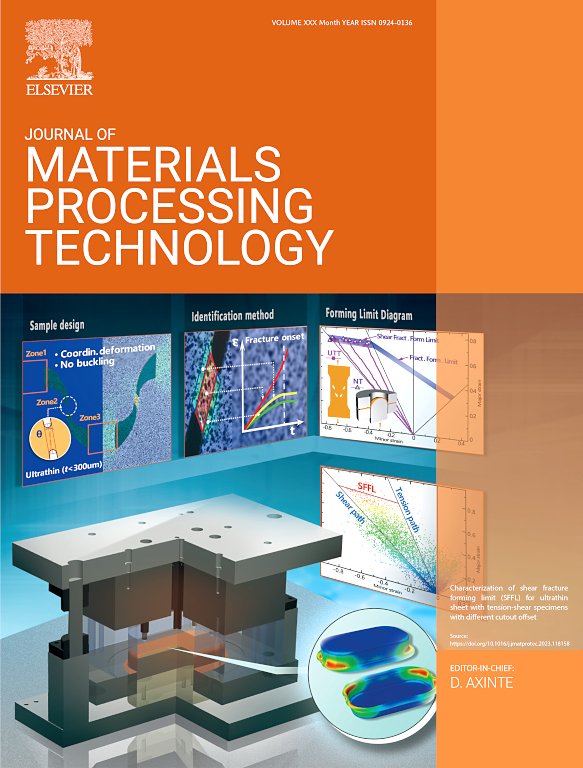通过热压和发泡工艺实现钢面板/铝泡沫夹层的冶金结合:界面微结构演变和拉伸行为
IF 6.7
2区 材料科学
Q1 ENGINEERING, INDUSTRIAL
Journal of Materials Processing Technology
Pub Date : 2024-10-11
DOI:10.1016/j.jmatprotec.2024.118636
引用次数: 0
摘要
本研究介绍了一种通过冶金粘合制造铝泡沫夹层和镀铝钢面板的创新方法。该工艺包括使用通过熔融搅拌制备的可发泡前驱体,以及随后的热压和发泡,为生产轻质结构材料和连接钢铝异种金属提供了一种具有成本效益和工业可行性的方法。本研究重点探讨了发泡前后粘接界面微观结构的变化,并揭示了这些变化对拉伸结果的影响。发泡实验表明,可发泡夹层具有优异的发泡能力,发泡后的芯层密度介于 0.283 和 0.591 g/cm ³ 之间。微结构表征结果表明,在热压过程中,界面铁侧观察到细小的等轴晶粒,表明发生了动态再结晶。界面上形成的少量 η-Al5Fe2 是导致断裂路径偏移的主要因素。随后,在发泡过程中,金属间化合物(IMC)θ-Al13Fe4、τ5-Al7Fe2Si 和 β-Al4.5FeSi 依次形成,这主要是由硅元素的扩散反应决定的。这些 IMC 的形成导致了界面微硬度的增加和剪切强度的降低。利用数字图像相关性研究了拉伸载荷下的应变分布。结果表明,损伤累积的特征是应变带的形成和扩展,破坏表现为这些应变带的相互连接。本文章由计算机程序翻译,如有差异,请以英文原文为准。
Achieving metallurgical bonding in steel faceplate/aluminum foam sandwich via hot pressing and foaming processes: interfacial microstructure evolution and tensile behavior
This study introduces an innovative approach to fabricating aluminum foam sandwich with aluminized steel faceplates through metallurgical bonding. The process involves the use of foamable precursor, prepared via melt stirring, and subsequent hot pressing and foaming, offering a cost-effective and industrially feasible method for producing lightweight structural materials and connection of steel/aluminum dissimilar metals. This study focuses on exploring the changes in the microstructure of the bonding interface before and after foaming, and revealing the impact of these changes on the tensile results. Foaming experiment shows that foamable sandwiches have superior foaming ability, and the core layer density after foaming is between 0.283 and 0.591 g/cm ³. Microstructural characterization results demonstrate that, during the hot pressing process, fine equiaxed grains are observed on the iron side of the interface, indicating dynamic recrystallization occurred. The formation of a small amount of η-Al5Fe2 at the interface is a primary factor causing the deflection of the fracture path. Subsequently, during the foaming process, intermetallic compounds (IMCs) θ-Al13Fe4, τ5-Al7Fe2Si, and β-Al4.5FeSi formed sequentially, mainly determined by the diffusion reaction of silicon elements. The formation of these IMCs led to an increase in microhardness at the interface and a decrease in shear strength. Digital image correlation was utilized to examine strain distribution under tensile loading. The result indicates that the damage accumulation is characterized by the formation and expansion of strain bands, with failure manifested as the interconnection of these strain bands.
求助全文
通过发布文献求助,成功后即可免费获取论文全文。
去求助
来源期刊

Journal of Materials Processing Technology
工程技术-材料科学:综合
CiteScore
12.60
自引率
4.80%
发文量
403
审稿时长
29 days
期刊介绍:
The Journal of Materials Processing Technology covers the processing techniques used in manufacturing components from metals and other materials. The journal aims to publish full research papers of original, significant and rigorous work and so to contribute to increased production efficiency and improved component performance.
Areas of interest to the journal include:
• Casting, forming and machining
• Additive processing and joining technologies
• The evolution of material properties under the specific conditions met in manufacturing processes
• Surface engineering when it relates specifically to a manufacturing process
• Design and behavior of equipment and tools.
 求助内容:
求助内容: 应助结果提醒方式:
应助结果提醒方式:


